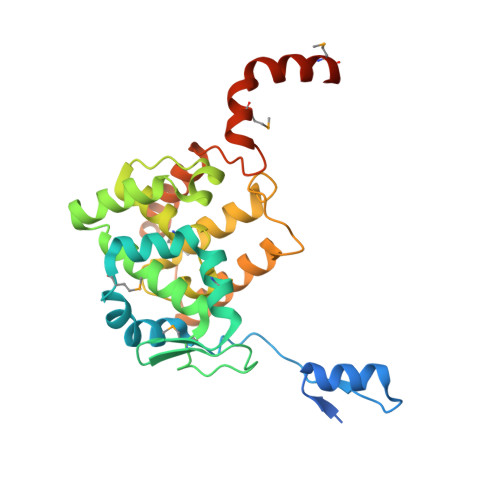Asymmetric Trimeric Ring Structure of the Nucleocapsid Protein of Tospovirus.
Komoda, K., Narita, M., Yamashita, K., Tanaka, I., Yao, M.(2017) J Virol 91
- PubMed: 28768868
- DOI: https://doi.org/10.1128/JVI.01002-17
- Primary Citation of Related Structures:
5IP1, 5IP2, 5IP3 - PubMed Abstract:
Tomato spotted wilt virus (TSWV), belonging to the genus Tospovirus of the family Bunyaviridae , causes significant economic damage to several vegetables and ornamental plants worldwide. Similar to those of all other negative-strand RNA viruses, the nucleocapsid (N) protein plays very important roles in its viral life cycle. N proteins protect genomic RNAs by encapsidation and form a viral ribonucleoprotein complex (vRNP) with some RNA-dependent RNA polymerases. Here we show the crystal structure of the N protein from TSWV. Protomers of TSWV N proteins consist of three parts: the N arm, C arm, and core domain. Unlike N proteins of other negative-strand RNA viruses, the TSWV N protein forms an asymmetric trimeric ring. To form the trimeric ring, the N and C arms of the N protein interact with the core domains of two adjacent N proteins. By solving the crystal structures of the TSWV N protein with nucleic acids, we showed that an inner cleft of the asymmetric trimeric ring is an RNA-binding site. These characteristics are similar to those of N proteins of other viruses of the family Bunyaviridae Based on these observations, we discuss possibilities of a TSWV encapsidation model. IMPORTANCE Tospoviruses cause significant crop losses throughout the world. Particularly, TSWV has an extremely wide host range (>1,000 plant species, including dicots and monocots), and worldwide losses are estimated to be in excess of $1 billion annually. Despite such importance, no proteins of tospoviruses have been elucidated so far. Among TSWV-encoded proteins, the N protein is required for assembling the viral genomic RNA into the viral ribonucleoprotein (vRNP), which is involved in various steps of the life cycle of these viruses, such as RNA replication, virus particle formation, and cell-to-cell movement. This study revealed the structure of the N protein, with or without nucleic acids, of TSWV as the first virus of the genus Tospovirus , so it completed our view of the N proteins of the family Bunyaviridae .
Organizational Affiliation:
Graduate School of Life Sciences, Hokkaido University, Sapporo, Hokkaido, Japan komoda.k@gmail.com yao@castor.sci.hokudai.ac.jp.















